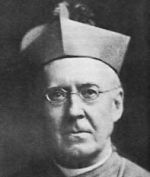Sunday, September 7th marks the 90th anniversary of the death of Bishop Chatard. He was born in Baltimore,  on December 13, 1834 to Ferdinand E. Chatard and Eliza Anna Marean. He studied at Mount St. Mary’s in Emmitsburg and became a Doctor of Medicine. He worked in the City Dispensary in Baltimore. It was perhaps there that heard a call to the priesthood and he was sent to Rome to study. He was ordained at Rome, June 14, 1862. and shortly afterward was named Vice-rector of the North American College. The Rector of the College at that time was William George McCloskey, who was named Bishop of Louisville in 1868.
on December 13, 1834 to Ferdinand E. Chatard and Eliza Anna Marean. He studied at Mount St. Mary’s in Emmitsburg and became a Doctor of Medicine. He worked in the City Dispensary in Baltimore. It was perhaps there that heard a call to the priesthood and he was sent to Rome to study. He was ordained at Rome, June 14, 1862. and shortly afterward was named Vice-rector of the North American College. The Rector of the College at that time was William George McCloskey, who was named Bishop of Louisville in 1868.
Chatard then became Rector and served until 1878 when he was named Bishop of Vincennes. During his time as Rector of the North American College the First Vatican Council was held. This allowed Chatard to meet and interact with many American Bishops who stayed at the College while in Rome. Chatard was apparently a favorite of Pope Pius IX. His Roman experience apparently fortified his views when he came back to the U.S. Chatard made a number of visits to the United States seeking funds for the American College.
Shortly after the election of Pope Leo XIII, Chatard was named bishop of Vincennes. This was on March 26, 1878, at which time he took the name Francis Silas. His baptismal name was Silas Francis. He was consecrated in Rome, May 12, 1878, by Cardinal Alexander Camillus Franchi, assisted by Bishop Santori of Fano, Italy, and Bishop Edward Agnelli, president of the Academia Ecclesiastica at Rome. Chatard was “enthroned” in the cathedral of St. Francis Xavier at Vincennes on August 11, 1878. Chatard apparently had no intention of staying in Vincennes. He had sought and received permission to live in Indianapolis, where he arrived on August 17, 1878. In 1898 the See was officially moved and renamed the Diocese of Indianapolis.
While Bishop of Vincennes/Indianapolis, Chatard brought the diocese into the 20th century. He showed a great deal of support for the institutions of the diocese and he founded numerous parishes. During his time, Chatard generally sided with the more conservative side of the American church. This included his opposition to the Knights of Labor, not because of any opposition to workers rights, but because of a fear of so called, Secret Societies. This was balanced by support for the organization by the so-called “Liberal” side of the American Church, led by Archbishop (and Cardinal) James Gibbons of Baltimore and Bishop John Keane of Richmond. The battles between the two sides over the role of organized labor had begun earlier, especially with situations such as the McGlynn Affair which pitted Corrigan against Gibbons. We might look back and wonder if anything has really changed since those times were also a time of great upheaval in the American Church. Many accomplishments took place during this period as well. Chatard attended the Third Plenary Council of Baltimore which made a number of changes in the American Church, especially in terms of Catholic education.
Chatard, as mentioned ealier, oversaw and promoted the transfer of the See of Vincennes to Indianapolis in 1898. Chatard had two auxiliary bishops. The first was Denis O’Donaghue, who was named Bishop of Lousiville in 1910, upon the death of McCloskey. The second was Joseph Chartrand who would later succeed Chatard. Chatard died at Indianapolis on September 7, 1918. His body was interred in the crypt of the Cathedral of Sts. Peter and Paul,  which he built in Indianapolis. On June 8, 1976, Bishop Chatard’s remains were transferred from the cathedral, Indianapolis, to the Calvary Chapel Mausoleum, Indianapolis.
which he built in Indianapolis. On June 8, 1976, Bishop Chatard’s remains were transferred from the cathedral, Indianapolis, to the Calvary Chapel Mausoleum, Indianapolis.
The ironies abound in our history with Chatard’s association with Baltimore and Mount St. Mary’s and Bishop Brute. Chatard’s sister became a member of Mother Seton’s Daughters of Charity. Chartrand’s birth in St. Louis which began a long tradition of “sharing” (Ritter, Schulte, O’Meara).
Chatard was honored with the naming of an Indianapolis high school which opened in 1961.